US-China Trade Restrictions: Impact and Response Analysis on Australia
VerifiedAdded on 2023/01/20
|7
|1394
|54
Essay
AI Summary
This essay examines the trade relationship between the USA and China, focusing on the recent trade restrictions imposed by the US and China's retaliatory response. It explores the impact of these trade restrictions on the Australian economy, highlighting the potential slowdown in economic growth due to reduced global demand and its effects on Australian exporters, miners, manufacturers, and farmers. The analysis includes the adverse effects on Australia's GDP, potential job losses, and the weakening of the Chinese currency affecting education exports. While some sectors like LNG and steel may benefit, the overall impact suggests a significant economic challenge for Australia. The essay also delves into China's tariff retaliation strategy, based on international trade theory, and its implications for both the US and China.
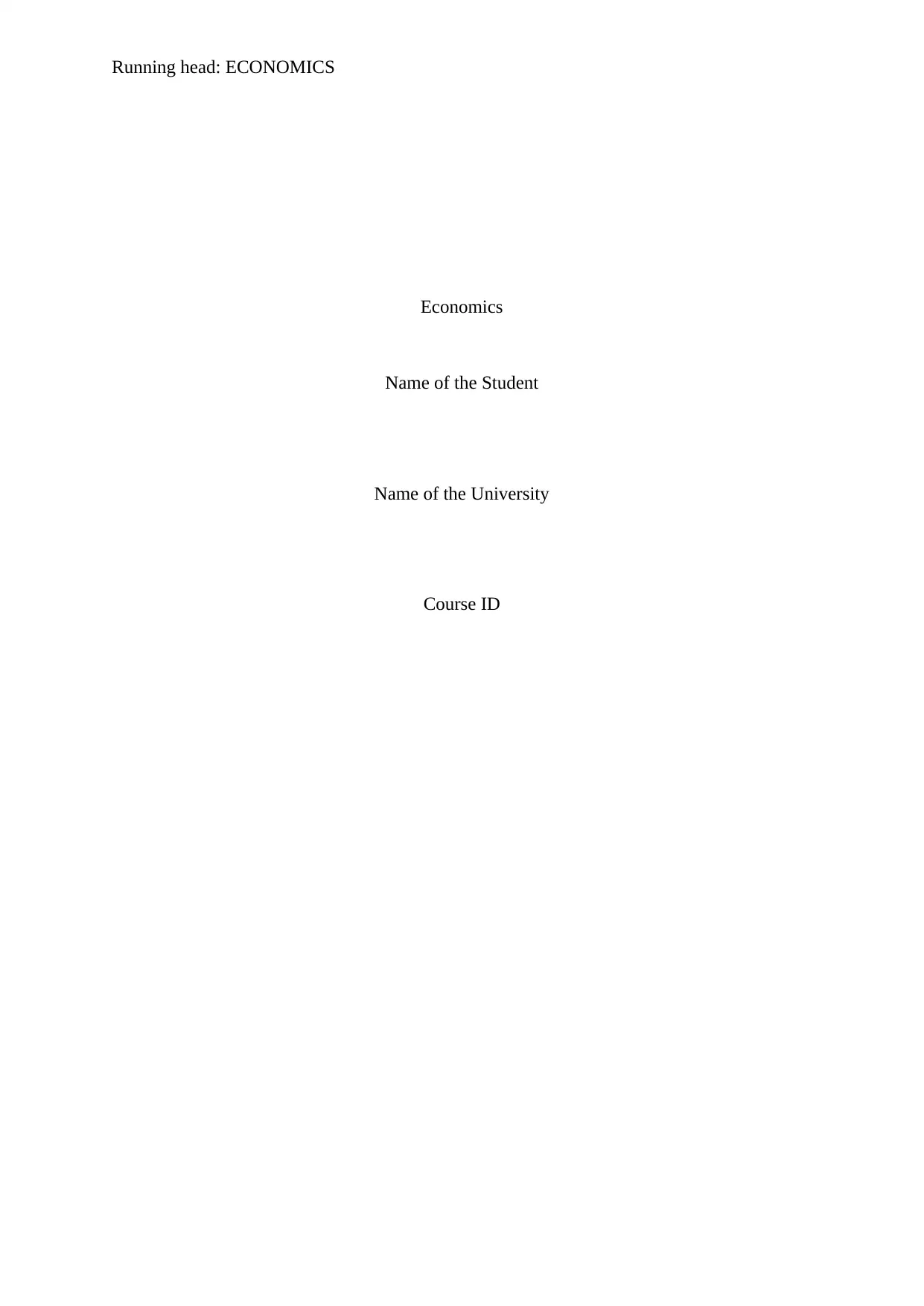
Running head: ECONOMICS
Economics
Name of the Student
Name of the University
Course ID
Economics
Name of the Student
Name of the University
Course ID
Paraphrase This Document
Need a fresh take? Get an instant paraphrase of this document with our AI Paraphraser
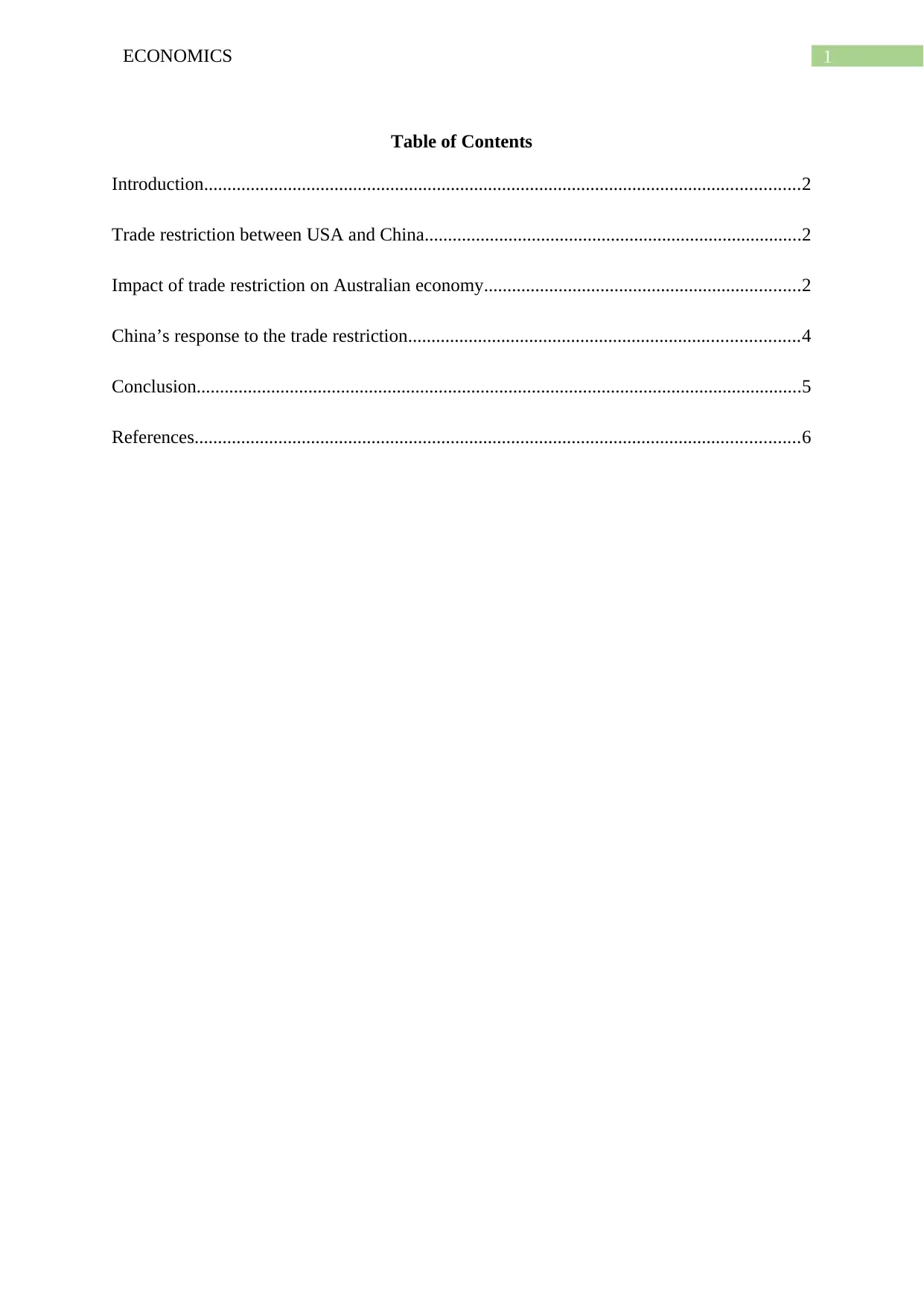
1ECONOMICS
Table of Contents
Introduction................................................................................................................................2
Trade restriction between USA and China.................................................................................2
Impact of trade restriction on Australian economy....................................................................2
China’s response to the trade restriction....................................................................................4
Conclusion..................................................................................................................................5
References..................................................................................................................................6
Table of Contents
Introduction................................................................................................................................2
Trade restriction between USA and China.................................................................................2
Impact of trade restriction on Australian economy....................................................................2
China’s response to the trade restriction....................................................................................4
Conclusion..................................................................................................................................5
References..................................................................................................................................6
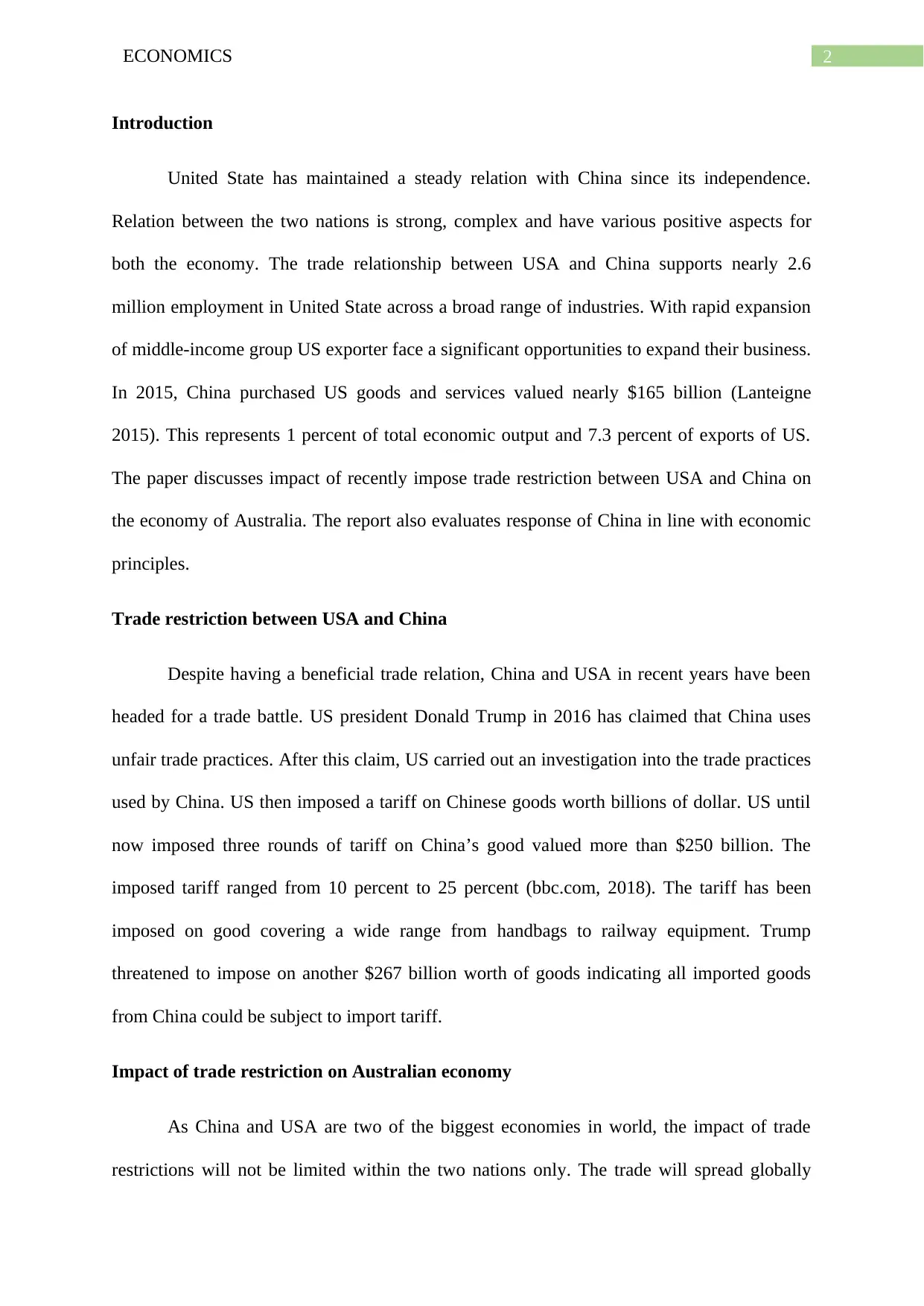
2ECONOMICS
Introduction
United State has maintained a steady relation with China since its independence.
Relation between the two nations is strong, complex and have various positive aspects for
both the economy. The trade relationship between USA and China supports nearly 2.6
million employment in United State across a broad range of industries. With rapid expansion
of middle-income group US exporter face a significant opportunities to expand their business.
In 2015, China purchased US goods and services valued nearly $165 billion (Lanteigne
2015). This represents 1 percent of total economic output and 7.3 percent of exports of US.
The paper discusses impact of recently impose trade restriction between USA and China on
the economy of Australia. The report also evaluates response of China in line with economic
principles.
Trade restriction between USA and China
Despite having a beneficial trade relation, China and USA in recent years have been
headed for a trade battle. US president Donald Trump in 2016 has claimed that China uses
unfair trade practices. After this claim, US carried out an investigation into the trade practices
used by China. US then imposed a tariff on Chinese goods worth billions of dollar. US until
now imposed three rounds of tariff on China’s good valued more than $250 billion. The
imposed tariff ranged from 10 percent to 25 percent (bbc.com, 2018). The tariff has been
imposed on good covering a wide range from handbags to railway equipment. Trump
threatened to impose on another $267 billion worth of goods indicating all imported goods
from China could be subject to import tariff.
Impact of trade restriction on Australian economy
As China and USA are two of the biggest economies in world, the impact of trade
restrictions will not be limited within the two nations only. The trade will spread globally
Introduction
United State has maintained a steady relation with China since its independence.
Relation between the two nations is strong, complex and have various positive aspects for
both the economy. The trade relationship between USA and China supports nearly 2.6
million employment in United State across a broad range of industries. With rapid expansion
of middle-income group US exporter face a significant opportunities to expand their business.
In 2015, China purchased US goods and services valued nearly $165 billion (Lanteigne
2015). This represents 1 percent of total economic output and 7.3 percent of exports of US.
The paper discusses impact of recently impose trade restriction between USA and China on
the economy of Australia. The report also evaluates response of China in line with economic
principles.
Trade restriction between USA and China
Despite having a beneficial trade relation, China and USA in recent years have been
headed for a trade battle. US president Donald Trump in 2016 has claimed that China uses
unfair trade practices. After this claim, US carried out an investigation into the trade practices
used by China. US then imposed a tariff on Chinese goods worth billions of dollar. US until
now imposed three rounds of tariff on China’s good valued more than $250 billion. The
imposed tariff ranged from 10 percent to 25 percent (bbc.com, 2018). The tariff has been
imposed on good covering a wide range from handbags to railway equipment. Trump
threatened to impose on another $267 billion worth of goods indicating all imported goods
from China could be subject to import tariff.
Impact of trade restriction on Australian economy
As China and USA are two of the biggest economies in world, the impact of trade
restrictions will not be limited within the two nations only. The trade will spread globally
⊘ This is a preview!⊘
Do you want full access?
Subscribe today to unlock all pages.

Trusted by 1+ million students worldwide
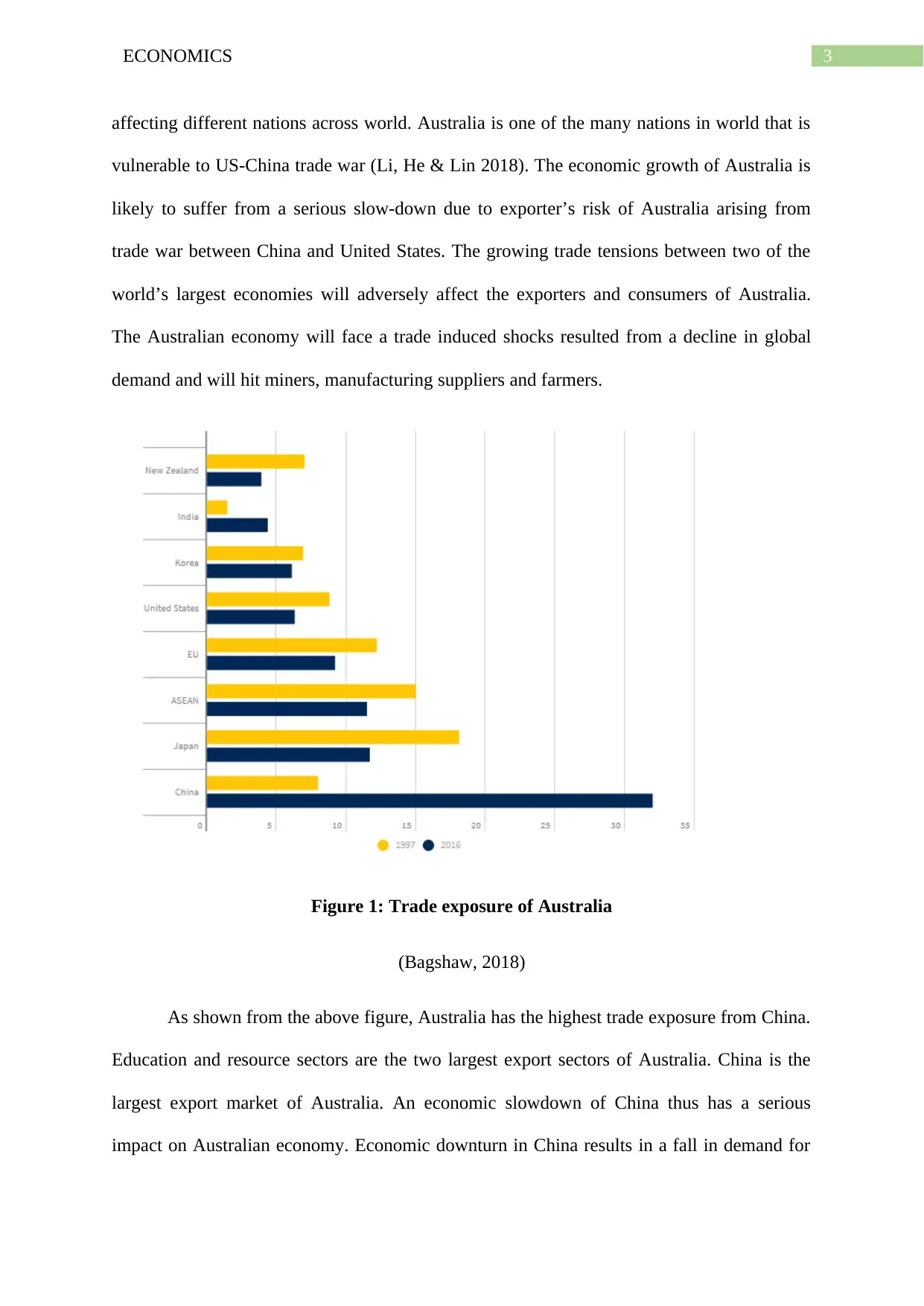
3ECONOMICS
affecting different nations across world. Australia is one of the many nations in world that is
vulnerable to US-China trade war (Li, He & Lin 2018). The economic growth of Australia is
likely to suffer from a serious slow-down due to exporter’s risk of Australia arising from
trade war between China and United States. The growing trade tensions between two of the
world’s largest economies will adversely affect the exporters and consumers of Australia.
The Australian economy will face a trade induced shocks resulted from a decline in global
demand and will hit miners, manufacturing suppliers and farmers.
Figure 1: Trade exposure of Australia
(Bagshaw, 2018)
As shown from the above figure, Australia has the highest trade exposure from China.
Education and resource sectors are the two largest export sectors of Australia. China is the
largest export market of Australia. An economic slowdown of China thus has a serious
impact on Australian economy. Economic downturn in China results in a fall in demand for
affecting different nations across world. Australia is one of the many nations in world that is
vulnerable to US-China trade war (Li, He & Lin 2018). The economic growth of Australia is
likely to suffer from a serious slow-down due to exporter’s risk of Australia arising from
trade war between China and United States. The growing trade tensions between two of the
world’s largest economies will adversely affect the exporters and consumers of Australia.
The Australian economy will face a trade induced shocks resulted from a decline in global
demand and will hit miners, manufacturing suppliers and farmers.
Figure 1: Trade exposure of Australia
(Bagshaw, 2018)
As shown from the above figure, Australia has the highest trade exposure from China.
Education and resource sectors are the two largest export sectors of Australia. China is the
largest export market of Australia. An economic slowdown of China thus has a serious
impact on Australian economy. Economic downturn in China results in a fall in demand for
Paraphrase This Document
Need a fresh take? Get an instant paraphrase of this document with our AI Paraphraser
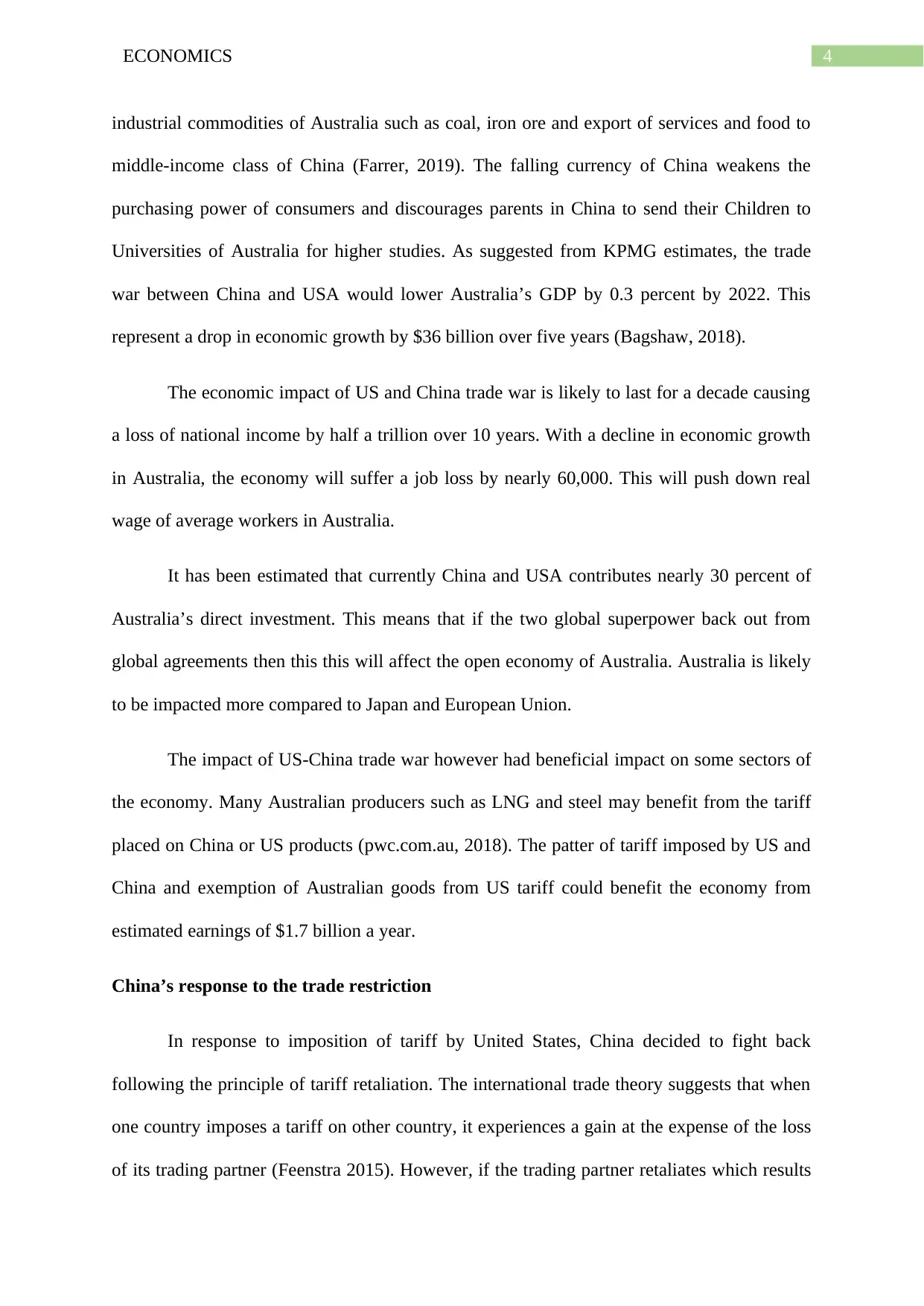
4ECONOMICS
industrial commodities of Australia such as coal, iron ore and export of services and food to
middle-income class of China (Farrer, 2019). The falling currency of China weakens the
purchasing power of consumers and discourages parents in China to send their Children to
Universities of Australia for higher studies. As suggested from KPMG estimates, the trade
war between China and USA would lower Australia’s GDP by 0.3 percent by 2022. This
represent a drop in economic growth by $36 billion over five years (Bagshaw, 2018).
The economic impact of US and China trade war is likely to last for a decade causing
a loss of national income by half a trillion over 10 years. With a decline in economic growth
in Australia, the economy will suffer a job loss by nearly 60,000. This will push down real
wage of average workers in Australia.
It has been estimated that currently China and USA contributes nearly 30 percent of
Australia’s direct investment. This means that if the two global superpower back out from
global agreements then this this will affect the open economy of Australia. Australia is likely
to be impacted more compared to Japan and European Union.
The impact of US-China trade war however had beneficial impact on some sectors of
the economy. Many Australian producers such as LNG and steel may benefit from the tariff
placed on China or US products (pwc.com.au, 2018). The patter of tariff imposed by US and
China and exemption of Australian goods from US tariff could benefit the economy from
estimated earnings of $1.7 billion a year.
China’s response to the trade restriction
In response to imposition of tariff by United States, China decided to fight back
following the principle of tariff retaliation. The international trade theory suggests that when
one country imposes a tariff on other country, it experiences a gain at the expense of the loss
of its trading partner (Feenstra 2015). However, if the trading partner retaliates which results
industrial commodities of Australia such as coal, iron ore and export of services and food to
middle-income class of China (Farrer, 2019). The falling currency of China weakens the
purchasing power of consumers and discourages parents in China to send their Children to
Universities of Australia for higher studies. As suggested from KPMG estimates, the trade
war between China and USA would lower Australia’s GDP by 0.3 percent by 2022. This
represent a drop in economic growth by $36 billion over five years (Bagshaw, 2018).
The economic impact of US and China trade war is likely to last for a decade causing
a loss of national income by half a trillion over 10 years. With a decline in economic growth
in Australia, the economy will suffer a job loss by nearly 60,000. This will push down real
wage of average workers in Australia.
It has been estimated that currently China and USA contributes nearly 30 percent of
Australia’s direct investment. This means that if the two global superpower back out from
global agreements then this this will affect the open economy of Australia. Australia is likely
to be impacted more compared to Japan and European Union.
The impact of US-China trade war however had beneficial impact on some sectors of
the economy. Many Australian producers such as LNG and steel may benefit from the tariff
placed on China or US products (pwc.com.au, 2018). The patter of tariff imposed by US and
China and exemption of Australian goods from US tariff could benefit the economy from
estimated earnings of $1.7 billion a year.
China’s response to the trade restriction
In response to imposition of tariff by United States, China decided to fight back
following the principle of tariff retaliation. The international trade theory suggests that when
one country imposes a tariff on other country, it experiences a gain at the expense of the loss
of its trading partner (Feenstra 2015). However, if the trading partner retaliates which results
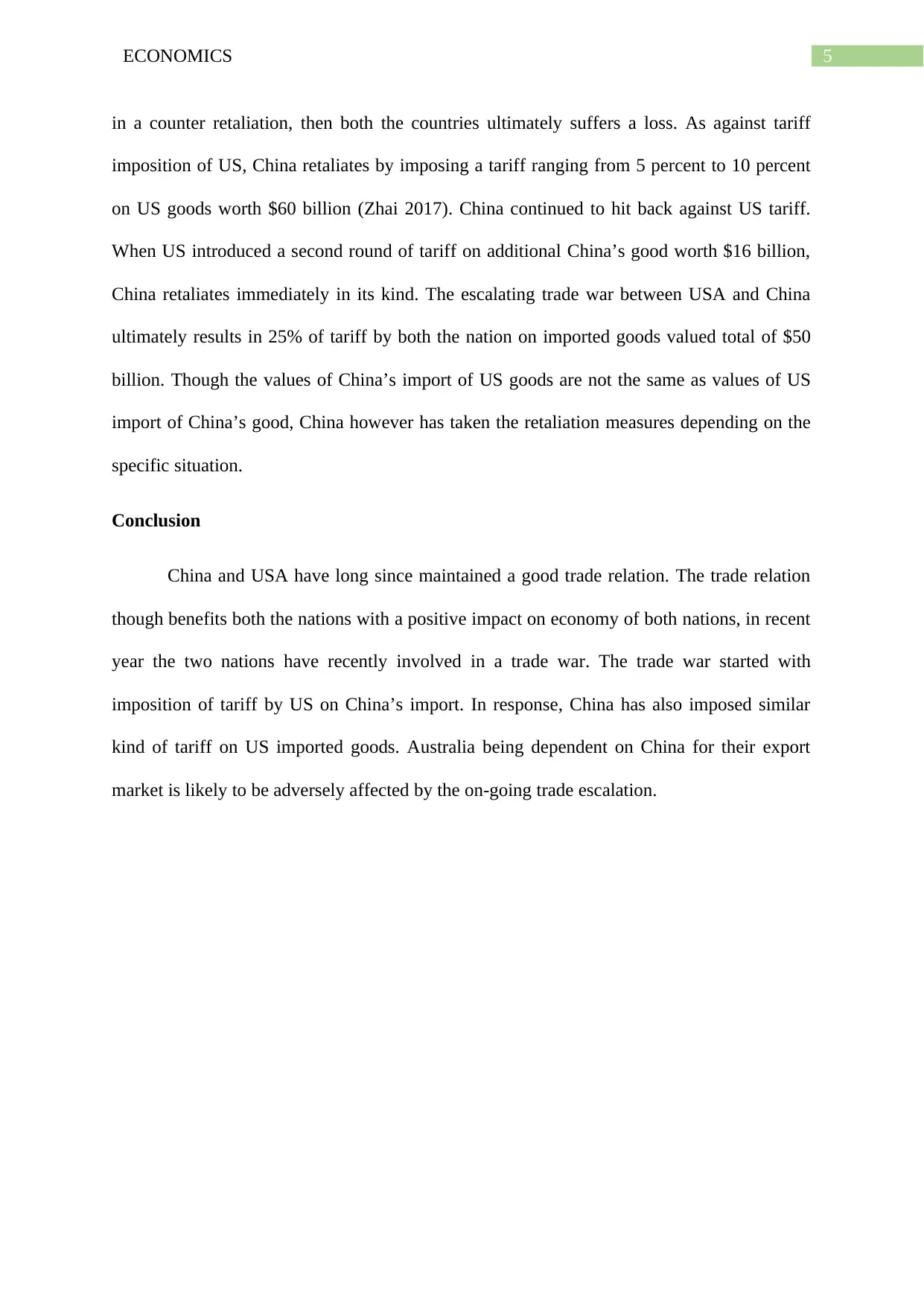
5ECONOMICS
in a counter retaliation, then both the countries ultimately suffers a loss. As against tariff
imposition of US, China retaliates by imposing a tariff ranging from 5 percent to 10 percent
on US goods worth $60 billion (Zhai 2017). China continued to hit back against US tariff.
When US introduced a second round of tariff on additional China’s good worth $16 billion,
China retaliates immediately in its kind. The escalating trade war between USA and China
ultimately results in 25% of tariff by both the nation on imported goods valued total of $50
billion. Though the values of China’s import of US goods are not the same as values of US
import of China’s good, China however has taken the retaliation measures depending on the
specific situation.
Conclusion
China and USA have long since maintained a good trade relation. The trade relation
though benefits both the nations with a positive impact on economy of both nations, in recent
year the two nations have recently involved in a trade war. The trade war started with
imposition of tariff by US on China’s import. In response, China has also imposed similar
kind of tariff on US imported goods. Australia being dependent on China for their export
market is likely to be adversely affected by the on-going trade escalation.
in a counter retaliation, then both the countries ultimately suffers a loss. As against tariff
imposition of US, China retaliates by imposing a tariff ranging from 5 percent to 10 percent
on US goods worth $60 billion (Zhai 2017). China continued to hit back against US tariff.
When US introduced a second round of tariff on additional China’s good worth $16 billion,
China retaliates immediately in its kind. The escalating trade war between USA and China
ultimately results in 25% of tariff by both the nation on imported goods valued total of $50
billion. Though the values of China’s import of US goods are not the same as values of US
import of China’s good, China however has taken the retaliation measures depending on the
specific situation.
Conclusion
China and USA have long since maintained a good trade relation. The trade relation
though benefits both the nations with a positive impact on economy of both nations, in recent
year the two nations have recently involved in a trade war. The trade war started with
imposition of tariff by US on China’s import. In response, China has also imposed similar
kind of tariff on US imported goods. Australia being dependent on China for their export
market is likely to be adversely affected by the on-going trade escalation.
⊘ This is a preview!⊘
Do you want full access?
Subscribe today to unlock all pages.

Trusted by 1+ million students worldwide
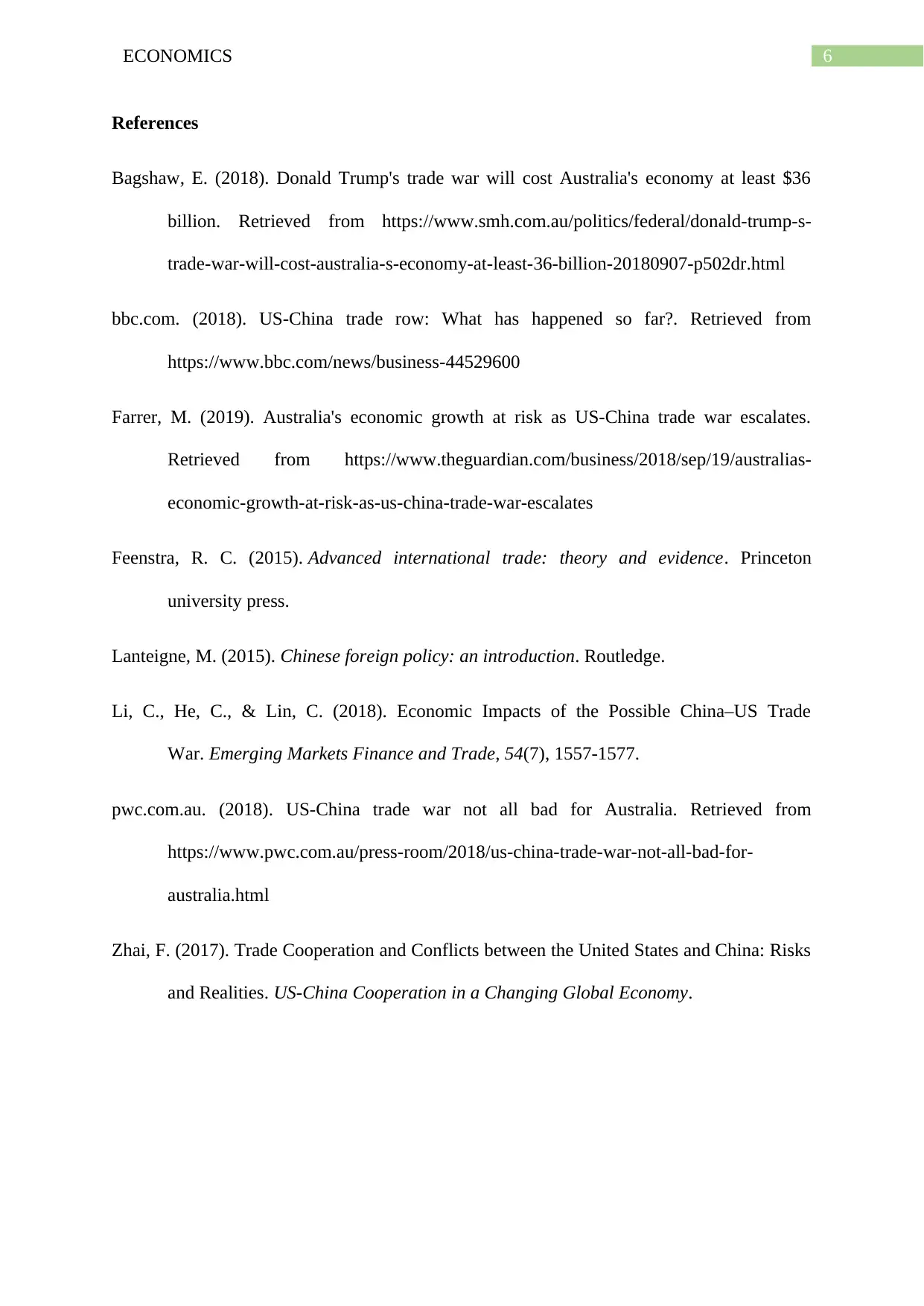
6ECONOMICS
References
Bagshaw, E. (2018). Donald Trump's trade war will cost Australia's economy at least $36
billion. Retrieved from https://www.smh.com.au/politics/federal/donald-trump-s-
trade-war-will-cost-australia-s-economy-at-least-36-billion-20180907-p502dr.html
bbc.com. (2018). US-China trade row: What has happened so far?. Retrieved from
https://www.bbc.com/news/business-44529600
Farrer, M. (2019). Australia's economic growth at risk as US-China trade war escalates.
Retrieved from https://www.theguardian.com/business/2018/sep/19/australias-
economic-growth-at-risk-as-us-china-trade-war-escalates
Feenstra, R. C. (2015). Advanced international trade: theory and evidence. Princeton
university press.
Lanteigne, M. (2015). Chinese foreign policy: an introduction. Routledge.
Li, C., He, C., & Lin, C. (2018). Economic Impacts of the Possible China–US Trade
War. Emerging Markets Finance and Trade, 54(7), 1557-1577.
pwc.com.au. (2018). US-China trade war not all bad for Australia. Retrieved from
https://www.pwc.com.au/press-room/2018/us-china-trade-war-not-all-bad-for-
australia.html
Zhai, F. (2017). Trade Cooperation and Conflicts between the United States and China: Risks
and Realities. US-China Cooperation in a Changing Global Economy.
References
Bagshaw, E. (2018). Donald Trump's trade war will cost Australia's economy at least $36
billion. Retrieved from https://www.smh.com.au/politics/federal/donald-trump-s-
trade-war-will-cost-australia-s-economy-at-least-36-billion-20180907-p502dr.html
bbc.com. (2018). US-China trade row: What has happened so far?. Retrieved from
https://www.bbc.com/news/business-44529600
Farrer, M. (2019). Australia's economic growth at risk as US-China trade war escalates.
Retrieved from https://www.theguardian.com/business/2018/sep/19/australias-
economic-growth-at-risk-as-us-china-trade-war-escalates
Feenstra, R. C. (2015). Advanced international trade: theory and evidence. Princeton
university press.
Lanteigne, M. (2015). Chinese foreign policy: an introduction. Routledge.
Li, C., He, C., & Lin, C. (2018). Economic Impacts of the Possible China–US Trade
War. Emerging Markets Finance and Trade, 54(7), 1557-1577.
pwc.com.au. (2018). US-China trade war not all bad for Australia. Retrieved from
https://www.pwc.com.au/press-room/2018/us-china-trade-war-not-all-bad-for-
australia.html
Zhai, F. (2017). Trade Cooperation and Conflicts between the United States and China: Risks
and Realities. US-China Cooperation in a Changing Global Economy.
1 out of 7
Related Documents
Your All-in-One AI-Powered Toolkit for Academic Success.
+13062052269
info@desklib.com
Available 24*7 on WhatsApp / Email
![[object Object]](/_next/static/media/star-bottom.7253800d.svg)
Unlock your academic potential
Copyright © 2020–2025 A2Z Services. All Rights Reserved. Developed and managed by ZUCOL.





